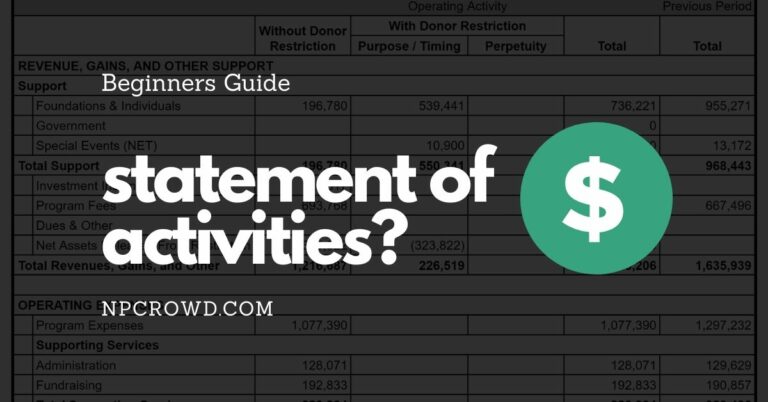Understanding Net Assets in the Nonprofit Sector
Disclaimer: This post may contain affiliate links. These links, if used and purchases made, we may earn a small commission. These affiliate programs do not impact the recommendations we make or the resources we refer you to. Our focus is on providing you the best resources for your nonprofit journey.
Net assets are a crucial concept in the nonprofit sector. Unlike for-profit businesses, nonprofits do not have owner’s equity or retained earnings. Instead, net assets represent the difference between what the organization owns and owes. In this article, we will explore the definition of net assets, the types of net assets, and their importance in the nonprofit sector. We will also discuss how to calculate net assets, manage them effectively, and report them in financial statements. Here are the key takeaways:Key Takeaways
- Net assets represent the difference between what a nonprofit organization owns and owes.
- There are two main types of net assets: unrestricted and restricted.
- Net assets are crucial for nonprofits as they determine the organization’s financial stability and ability to fulfill its mission.
- Calculating net assets involves subtracting total liabilities from total assets using the net assets formula.
- Managing net assets requires effective budgeting, financial planning, investment strategies, and fundraising efforts.
What are Net Assets?

Definition of Net Assets
Net assets are a key financial metric used in the nonprofit sector to measure the organization’s financial health and sustainability. They represent the residual interest in the organization’s assets after deducting liabilities. In simpler terms, net assets are the organization’s total assets minus its total liabilities. Net assets can be further categorized into two types: unrestricted net assets and restricted net assets.
Unrestricted net assets are the funds that are not subject to any donor-imposed restrictions and can be used by the organization for any purpose. These assets provide flexibility and serve as a cushion to absorb losses and protect debt investors. On the other hand, restricted net assets are earmarked for specific capital uses or program expenses as specified by the donors or governing authorities.
Calculating net assets involves subtracting total liabilities from total assets. The net assets formula is as follows: Net Assets = Total Assets – Total Liabilities. This formula provides a snapshot of the organization’s financial position and helps stakeholders assess its financial stability and capacity to fulfill its mission.
It is important for nonprofit organizations to effectively manage their net assets to ensure long-term sustainability. This includes budgeting and financial planning to allocate resources efficiently, implementing investment strategies to generate returns and grow net assets, and maintaining strong fundraising and donor relations to secure additional funding.
Reporting net assets is a crucial aspect of nonprofit financial management. Financial statements, including the balance sheet, provide a comprehensive overview of the organization’s net assets, liabilities, and equity. These statements are audited to ensure accuracy and compliance with accounting standards. Transparency and accountability in reporting net assets are essential for building trust with stakeholders and demonstrating the organization’s financial integrity.
Types of Net Assets
Net assets in the nonprofit sector are typically divided into two categories: unrestricted and restricted funds. Unrestricted net assets are funds that can be used for any purpose deemed necessary by the organization. These funds provide flexibility and allow nonprofits to allocate resources where they are most needed. On the other hand, restricted net assets are targeted for specific capital uses or program expenses. They are set aside for a particular purpose and cannot be used for other expenses. This ensures that funds are allocated appropriately and in accordance with donor restrictions or organizational goals.
When analyzing financial metrics related to net assets, it is important to consider the ratio of net assets to total assets. This ratio, calculated by dividing net assets by total assets, provides insight into the financial health and stability of a nonprofit. However, it is important to note that there is a lot of variability in these ratios and little correlation across different ratios. This means that a high unrestricted net asset ratio does not necessarily predict a high deployment ratio. Additionally, these ratios can vary significantly from year to year, both within individual organizations and across the sector as a whole.
In summary, understanding the types of net assets in the nonprofit sector is crucial for effective financial management. Unrestricted net assets provide flexibility, while restricted net assets ensure funds are used for their intended purpose. Analyzing the ratio of net assets to total assets can provide insights into a nonprofit’s financial health, but it is important to consider the variability and lack of correlation across different ratios.
Importance of Net Assets
Net assets are a crucial financial metric for nonprofit organizations. They represent the residual value of an organization’s assets after deducting liabilities. In simple terms, net assets reflect the organization’s financial health and sustainability.
One important aspect of net assets is the distinction between unrestricted and restricted net assets. Unrestricted net assets are available for general use and can be used to cover operating expenses, invest in new initiatives, or build reserves. On the other hand, restricted net assets are designated for specific purposes or programs.
Having a healthy level of net assets, particularly unrestricted net assets, provides a nonprofit with a cushion to absorb losses and protect debt investors. It also demonstrates the organization’s ability to weather financial challenges and maintain long-term stability.
It’s important for nonprofit leaders to carefully manage and monitor their net assets. By budgeting and engaging in financial planning, organizations can ensure they are effectively utilizing their resources and maintaining a positive net asset position. Additionally, investment strategies can help grow net assets over time, providing even greater financial stability.
Fundraising and donor relations also play a significant role in managing net assets. By cultivating strong relationships with donors and implementing effective fundraising strategies, nonprofits can increase their net assets through donations and grants.
In summary, net assets are a key indicator of a nonprofit’s financial health and sustainability. By maintaining a healthy level of net assets, managing them effectively, and engaging in strategic fundraising efforts, nonprofits can ensure their long-term success and impact.
Calculating Net Assets

Total Assets
Total assets refer to the sum of all the tangible and intangible resources owned by a nonprofit organization. These assets can include cash, investments, property, equipment, and more. They represent the financial strength and capacity of the organization to carry out its mission and programs.
Calculating the total assets involves taking into account all the assets listed on the organization’s balance sheet. This includes both current assets, which are those that can be easily converted into cash within a year, and non-current assets, which are long-term investments and property.
It is important for nonprofits to regularly assess and monitor their total assets to ensure financial stability and sustainability. By understanding the composition and value of their assets, organizations can make informed decisions about budgeting, investments, and resource allocation.
Note: The total assets of a nonprofit can vary significantly depending on the size, scope, and nature of its operations.
Total Liabilities
Total liabilities refer to the sum of all debts and obligations that a nonprofit organization owes to external parties. This includes loans, accounts payable, accrued expenses, and other financial obligations. It is an important financial metric that helps assess the organization’s financial health and its ability to meet its obligations.
Understanding the total liabilities is crucial for effective financial management. By accurately tracking and managing these liabilities, nonprofits can ensure that they have enough resources to cover their debts and maintain a positive cash flow. It also helps in making informed decisions regarding budgeting, fundraising, and investment strategies.
Table: Here is an example of a simplified balance sheet that shows the total liabilities of a nonprofit organization:
| Liabilities | Amount ($) |
|---|---|
| Loans | 50,000 |
| Accounts Payable | 10,000 |
| Accrued Expenses | 5,000 |
| Other Obligations | 2,000 |
| Total Liabilities | 67,000 |
Note: The amounts in this table are for illustrative purposes only and may vary for different organizations.
Tip: It is important for nonprofits to regularly review and analyze their total liabilities to ensure financial stability and sustainability. By effectively managing and reducing liabilities, organizations can improve their net assets and strengthen their financial position.
Net Assets Formula
The net assets formula is a calculation used to determine the net assets of a nonprofit organization. It is calculated by subtracting the total liabilities from the total assets. Net assets represent the residual interest in the organization’s assets after deducting liabilities. This formula provides valuable information about the financial health and stability of the organization.
To calculate the net assets, you need to know the total assets and total liabilities of the organization. Total assets include all the resources owned by the organization, such as cash, investments, property, and equipment. Total liabilities include all the debts and obligations of the organization, such as loans, accounts payable, and accrued expenses.
Once you have the total assets and total liabilities, you can use the net assets formula to calculate the net assets. The formula is as follows:
Net Assets = Total Assets – Total Liabilities
For example, if a nonprofit organization has total assets of $500,000 and total liabilities of $200,000, the net assets would be $300,000.
It’s important to regularly calculate and monitor the net assets of a nonprofit organization to ensure financial stability and sustainability. By understanding the net assets, organizations can make informed decisions about budgeting, financial planning, and investment strategies.
Managing Net Assets

Budgeting and Financial Planning
Budgeting and financial planning are crucial for the success and sustainability of nonprofit organizations. A financial plan helps nonprofits allocate limited resources efficiently, maximizing the impact of their programs and initiatives. It allows organizations to track progress and motivate staff and supporters. Resource optimization is key, and nonprofits should aim to spend no more than 35% of their funding on overhead expenses and 65% on programs, as recommended by the Better Business Bureau.
Financial planning also ensures legal compliance with nonprofit accounting standards, tax regulations, and reporting obligations. By following these standards, organizations can prevent legal issues and maintain their tax-exempt status. Transparency is another important aspect of financial management. Research shows that 51% of nonprofit leaders report outcome metrics to connect with donors. Transparent and responsible financial management builds trust with supporters and demonstrates a commitment to accountability.
In addition to compliance and transparency, financial planning contributes to the long-term sustainability of nonprofit organizations. By creating reserves, managing cash flow, and preparing for unforeseen circumstances, organizations can weather economic fluctuations and unexpected challenges. Strategic decision-making is also facilitated by proper fiscal management. Nonprofits can make smart choices based on their budget and goals, ensuring that resources are allocated effectively.
Budgeting and forecasting are both essential components of nonprofit accounting. Budgeting involves planning for predicted revenues in the future, while forecasting anticipates future income. Implementing a budget helps organizations achieve their goals, manage cash flow, and fulfill their fiduciary responsibilities. Forecasts provide insights into future financial performance and help organizations adapt and make informed decisions.
When developing a budget, nonprofits should consider various expenses, including programmatic costs, administrative costs, overhead expenses, fundraising costs, and personnel/staff costs. It is important to set up clear financial policies and procedures that outline how financial transactions will be handled, including approvals, record keeping, and reporting. By establishing these policies, nonprofits can ensure financial accountability and transparency.
Investment Strategies
When it comes to managing net assets, investment strategies play a crucial role. Nonprofit organizations need to carefully consider how they invest their assets to generate returns and support their mission. One important aspect is establishing clear financial goals. By setting specific and measurable targets that align with the organization’s mission and strategic objectives, nonprofits can ensure that their investments are purposeful and impactful.
Another key consideration is understanding the context-specific nature of the nonprofit sector. The sector is diverse, with different types of organizations and business models. This diversity creates challenges for large-scale institutional investors who are used to making decisions based on standardized approaches. It’s important for investors to assess each nonprofit organization in the context of its unique characteristics and closely defined peer groups.
In addition, nonprofits should be nimble and flexible in their investment approach. They need to be able to adapt to changing circumstances and seize opportunities when they arise. This requires staying informed about market trends, economic conditions, and emerging investment opportunities.
Lastly, it’s crucial for nonprofits to prioritize transparency and accountability in their investment strategies. Donors and stakeholders want to know how their funds are being invested and the impact they are making. Nonprofits should provide regular updates and reports on their investment activities, highlighting the outcomes achieved and the alignment with their mission.
In summary, investment strategies are a critical component of managing net assets for nonprofit organizations. By setting clear financial goals, understanding the sector’s context, being nimble in decision-making, and prioritizing transparency, nonprofits can optimize their investments and create meaningful impact.
Fundraising and Donor Relations
Fundraising and donor relations are crucial for nonprofit organizations. Building strong donor relationships is the key to attaining major gifts and endowments for your nonprofit. It allows nonprofits to secure the necessary funds to support their missions and make a positive impact in their communities. However, fundraising can be a challenging endeavor for many nonprofits. They often face limited resources, competition for donor dollars, and the need to continuously adapt. To maximize fundraising potential, nonprofits can consider the following strategies:
- Utilize donor management software to streamline giving processes, deepen donor relationships, and support more effective engagement strategies.
- Integrate customer relationship management (CRM) and fundraising platforms to enhance accuracy and quickly respond to accounting challenges.
- Collect and analyze donor-focused financial metrics, such as retention rates and contribution trends, to cultivate stronger relationships with donors and drive fundraising efforts.
Remember, strong donor relationships are built on trust, communication, and demonstrating the impact of donations. By implementing these strategies, nonprofits can strengthen their fundraising efforts and make a lasting difference in their communities.
Reporting Net Assets

Financial Statements
Financial statements are an essential tool for nonprofits to track and report their financial performance. These statements provide a snapshot of the organization’s finances over a specific period or up to a certain date. They include important information such as revenue, expenses, assets, and liabilities.
Nonprofits typically prepare three main financial statements: the Statement of Financial Position, the Statement of Activities, and the Statement of Cash Flows. The Statement of Financial Position shows the organization’s total assets, total liabilities, and net assets. It provides an analysis of the financial health of the nonprofit.
The Statement of Activities details the recognized revenue and expenses of the organization. It helps stakeholders understand how the nonprofit generates and uses its funds. Lastly, the Statement of Cash Flows discloses the amount of money raised and spent during a specific period. It breaks down the cash flows into operating, investing, and financing activities.
Preparing accurate and transparent financial statements is crucial for nonprofits. These statements should be prepared in accordance with generally accepted accounting principles (GAAP) to ensure accuracy and consistency. Nonprofits should also engage an independent auditor to review their financial statements and provide an objective assessment of their financial health.
In summary, financial statements play a vital role in providing a clear overview of a nonprofit’s financial position. They help stakeholders assess the organization’s financial health, make informed decisions, and ensure transparency and accountability.
Auditing and Compliance
Auditing and compliance are crucial aspects of managing net assets in the nonprofit sector. An audit is the highest level of attestation services provided by an independent CPA firm. It involves a thorough examination of an organization’s financial operations, management controls, and tax compliance. Auditors produce a comprehensive report of the organization’s financial information, including statements such as the Statement of Financial Position, Statement of Activities, Statement of Cash Flows, and related footnotes. This report attests that the financial information is free from material misstatements. Nonprofits often choose to have an audit done every year to demonstrate financial accountability to external stakeholders, such as funders.
Compliance with accounting and tax rules is essential for nonprofits to maintain their tax-exempt status. Nonprofits must adhere to Generally Accepted Accounting Principles (GAAP) and follow specialized fund accounting guidance. Rigorous recordkeeping is necessary to track program spending and administrative costs. Compliance not only ensures tax compliance but also helps build public trust and confidence. By demonstrating fiscal responsibility, nonprofits can earn the trust of donors and strengthen their ability to further their mission.
It’s important to understand the difference between an audit, a review, and a compilation. While an audit involves a comprehensive examination, a review is an objective evaluation of an organization’s financial records and management processes. A review may focus on specific areas or financial statements. On the other hand, a compilation involves presenting financial information without providing any assurance or evaluation. Nonprofits should consider their specific needs and requirements when deciding whether to undergo an audit, review, or compilation.
Nonprofit GAAP requirements play a crucial role in ensuring transparency and accountability. These requirements provide transparency for funders and assist the government in determining whether an organization should maintain its tax-exempt status. Conducting regular audits is important for nonprofits to accurately track their financial activities and comply with changes in laws and regulations. The frequency of audits depends on various factors, including the size of the nonprofit and the requirements of external stakeholders.
Transparency and Accountability
Transparency and accountability are crucial aspects of financial management in the nonprofit sector. By being transparent about their finances, nonprofits demonstrate their commitment to accountability and compliance with legal and regulatory requirements. This helps build trust with stakeholders and reduces the risk of legal issues or reputational damage.
To effectively build trust and accountability through financial transparency, nonprofits should focus on communicating financial information clearly and effectively. This can be done through the following:
- Providing regular financial reports to stakeholders, including donors, board members, and the public.
- Ensuring that financial information is easily accessible and understandable.
- Clearly explaining how funds are allocated and used.
By implementing these practices, nonprofits can foster transparency and accountability, which are essential for maintaining the trust and support of their stakeholders.
Frequently Asked Questions
What are net assets?
Net assets refer to the disparity between what a nonprofit organization owns and owes. It represents the organization’s financial position.
What are the types of net assets?
Net assets can be classified into unrestricted and restricted funds. Restricted funds can be further divided into permanently and temporarily restricted funds.
Why are net assets important?
Net assets are important because they indicate the financial health and stability of a nonprofit organization. They can be used to fund future endeavors and support the organization’s mission.
How are net assets calculated?
Net assets are calculated by subtracting total liabilities from total assets. The formula is: Net Assets = Total Assets – Total Liabilities.
What is the role of budgeting and financial planning in managing net assets?
Budgeting and financial planning help nonprofits allocate their net assets effectively, ensuring that funds are used in accordance with the organization’s goals and objectives.
How can investment strategies contribute to managing net assets?
Investment strategies can help nonprofits grow their net assets by generating additional income through smart investment decisions. This can provide long-term financial stability and support the organization’s mission.







